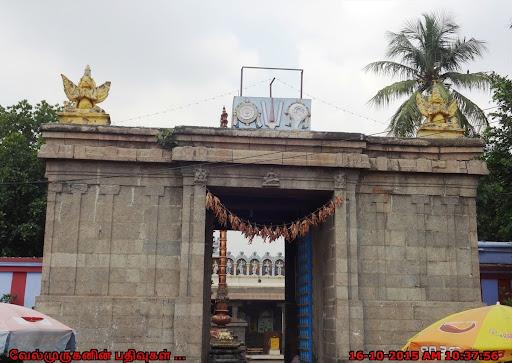When Lord Rama sent the pregnant Sita away, she took refuge in Sage Valmiki’s ashram in the forest of Veesharanyam, now Koyambedu. Sita gave birth to twins, Lava and Kusa, who lived as hermits. During an Aswamedha Yagna, Rama's horse reached Kosai Nagar (Koyambedu). Lava and Kusa captured the horse, leading to a fierce battle with Rama's battalion, including Bharatha, Shatrughna, and Lakshmana, all of whom were defeated by the boys. Rama himself battled them until Sage Valmiki revealed their identities. Rama stayed here as Vaikundavasa Perumal, with several sculptures depicting these events. The temple has an unfinished Rajagopuram, a bali peedam, and a tall copper-plated Kodi Maram. Notable are three closely arranged trees, symbolizing Siva, Parvathi, and Narayana. The main deity, Vaikundavasa Perumal, stands with Sri Devi and Bhu Devi, and a rare idol of Vaikhanasa Maharshi is present. There is a unique sannidhi for Rama and Sita, shown in simple attire from their forest exile, and a rare depiction of pregnant Sita with Lava and Kusa and Sage Valmiki. Thayaar Sri Kanagavalli and Sri Andal also have separate shrines.

Sri Vaikundavasa Perumal temple
Sri Vaikundavasa Perumal Temple, located in Koyambedu, Chennai, is adjacent to the Sri Kurungaleeswarar Temple. It is one of the oldest temples in Chennai, with inscriptions indicating it is 1500 years old. The temple was further developed during the 12th century by Kulothunga Chozhan and the Vijayanagar kings. Historical scriptures reveal that this area was once known as Kosai Nagar, Koyattipuram, and Prayachitham Puram. The temple's sacred tree (Thala Virutcham) is the Vilwa and Neem, and its holy water source (Theertham) is the Lavakucha Theertham.
Timings
Morning: 5:30 a.m. to 12:00 p.m. & Evening: 4:30 p.m. to 8:30 p.m.
Entry Fee
No entry fee is charged
Do's and Don'ts
- Respect: Show respect towards the deity, priests, and other devotees present in the temple.
- Dress Code: Dress modestly, covering shoulders and legs appropriately. Remove footwear before entering the inner sanctum.
- Offerings: Offer flowers, fruits, or other items as a gesture of devotion (check with temple guidelines for specific offerings).
- Follow Rituals: Participate respectfully in rituals and ceremonies conducted within the temple premises.
- Quiet and Clean: Maintain silence and cleanliness within the temple. Dispose of waste in designated bins.
- Photography: Follow guidelines regarding photography and avoid taking photos in sensitive or restricted areas.
- Footwear: Do not wear footwear inside the temple premises, especially in the inner sanctum.
- Disruption: Avoid causing disturbances during prayers or rituals by speaking loudly or engaging in inappropriate behavior.
- Non-Devotional Acts: Refrain from engaging in non-devotional activities such as eating, drinking, or smoking within the temple premises.
- Prohibited Areas: Respect areas marked as restricted or off-limits to visitors.
- Cultural Sensitivity: Avoid touching or pointing feet towards religious objects, idols, or persons.
- Personal Conduct: Maintain decorum and avoid discussions or activities that may distract from the temple's sacred atmosphere.
Dress Code
For Men: Wear shirts or traditional attire that covers the shoulders and chest. Preferably wear dhoti, veshti, or trousers. Shorts or tight-fitting clothing should be avoided.
For Women: Wear a saree, salwar kameez, or blouse with a skirt that covers the shoulders and midriff. Saree or long skirt and blouse. Avoid wearing short skirts or dresses.
How to reach
By Air : Chennai International Airport (MAA) is approximately 15-20 kilometres away from Koyambedu. Taxis, rental cars, or app-based ride services are available for travel to the temple.
By Road : Koyambedu is the nearest and largest bus stand of India, which is too near the temple.
Nearby Cities and Rivers
Rivers:
- Adyar River: Another significant river in Chennai, located south of Koyambedu.
Cities:
- Chennai: The temple is located within Chennai city, known for its cultural and economic significance in Tamil Nadu.
- Ambattur: A neighbouring industrial town to the northwest of Koyambedu.
- Porur: Situated to the southwest of Koyambedu, known for its residential and commercial development.
- Vadapalani: Located southeast of Koyambedu, famous for the Vadapalani Murugan Temple and other landmarks.